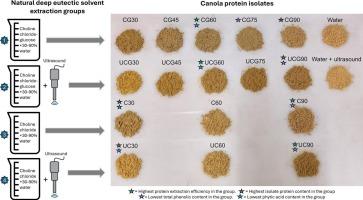Effects of natural deep eutectic solvents’ hydration level, choice of hydrogen bond donor and application of ultrasound on the extraction, anti-nutritional components, structural properties and functionality of canola protein isolates
IF 9.7
1区 化学
Q1 ACOUSTICS
引用次数: 0
Abstract
In a systematic attempt to improve the cost-effectiveness and knowledge of the topic of plant protein extraction using natural deep eutectic solvents (NDESs), 18 extraction treatments, half of which paired with sonication, were performed to extract canola protein isolates using two groups of NDESs: choline chloride-glucose-water (CG) and choline chloride-water (C), with water contents ranging from 30 to 90 %. The highest protein extraction efficiencies were observed at water contents of 60 % for CG group (50.28 %) and 90 % for C group (45.48 %), while sonication improved these efficiencies to 60.68 % and 58.11 %, respectively. Increased solvent hydration and sonication also effectively reduced phenolic compounds and phytic acid contents, especially in the CG group. Despite increasing the solvents’ viscosity and density, the combination of glucose and water as hydrogen bond donors proved more effective for protein extraction than water alone, especially for larger fractions such as cruciferins and aggregates. Furthermore, while protein secondary structure remained mostly intact, variations in solvents’ water content, and sonication, affected the tertiary structure and particle size distribution, with the strength and flexibility of the NDESs’ nanostructure possibly affecting the protein conformation and aggregation. Regarding functionality, sonicated isolates showed an average of 8.31 % lower aqueous solubility across the pH range of 3–7, along with more than double the emulsion stability and a lower foam stability at pH 3, compared to non-sonicated isolates. Overall, pushing NDESs to their upper hydration limit, proper selection of hydrogen bond donors, and the application of ultrasound can improve the cost-effectiveness and quality of extracted canola protein isolates.

天然深共晶溶剂水合水平、氢键供体选择和超声应用对油菜籽分离蛋白提取、抗营养成分、结构性质和功能的影响
为了提高植物蛋白提取的成本效益和知识,系统地尝试了18个提取处理,其中一半与超声相结合,使用两组ndeess:氯化胆碱-葡萄糖-水(CG)和氯化胆碱-水(C),水含量从30%到90%。CG组和C组的蛋白质提取率分别为60%(50.28%)和90%(45.48%),超声处理后蛋白质提取率分别为60.68%和58.11%。增加溶剂水合作用和超声作用也能有效降低酚类化合物和植酸含量,特别是在CG组。尽管增加了溶剂的粘度和密度,但葡萄糖和水作为氢键供体的组合被证明比单独使用水更有效地提取蛋白质,特别是对于十字花科植物和聚集体等较大的部分。此外,虽然蛋白质的二级结构基本保持完整,但溶剂含水量和超声作用的变化影响了三级结构和粒径分布,ness纳米结构的强度和柔韧性可能会影响蛋白质的构象和聚集。在功能方面,与非超声分离物相比,超声分离物在pH值3-7范围内的溶解度平均降低8.31%,乳液稳定性提高一倍以上,pH值3时泡沫稳定性降低。综上所述,将ness推至其水合上限,合理选择氢键供体,以及超声的应用,可以提高提取的油菜分离蛋白的成本效益和质量。
本文章由计算机程序翻译,如有差异,请以英文原文为准。
求助全文
约1分钟内获得全文
求助全文
来源期刊

Ultrasonics Sonochemistry
化学-化学综合
CiteScore
15.80
自引率
11.90%
发文量
361
审稿时长
59 days
期刊介绍:
Ultrasonics Sonochemistry stands as a premier international journal dedicated to the publication of high-quality research articles primarily focusing on chemical reactions and reactors induced by ultrasonic waves, known as sonochemistry. Beyond chemical reactions, the journal also welcomes contributions related to cavitation-induced events and processing, including sonoluminescence, and the transformation of materials on chemical, physical, and biological levels.
Since its inception in 1994, Ultrasonics Sonochemistry has consistently maintained a top ranking in the "Acoustics" category, reflecting its esteemed reputation in the field. The journal publishes exceptional papers covering various areas of ultrasonics and sonochemistry. Its contributions are highly regarded by both academia and industry stakeholders, demonstrating its relevance and impact in advancing research and innovation.
 求助内容:
求助内容: 应助结果提醒方式:
应助结果提醒方式:


